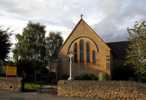 Stanton Hill Stanton Hill
All Saints
History
Stanton Hill originated as a small hamlet in the parish of Skegby. The village grew rapidly following the sinking of a pit and the building of houses for colliers by the Stanton Ironworks Company of Teversal. The growth of the mining industry resulted in a rapid increase in population and by 1894 there were over 3,000 living in the parish.
The first church in the village was a temporary mission room. This burnt down in March 1893 and a replacement opened the following year with substantial help from the Stanton Ironworks Company. Worship also took place in a number of schoolrooms. It quickly became clear however that a more sizable structure was required to accommodate the growing population of the village.
The church of All Saints was erected on Fackley Road in 1899 as a chapel-of-ease for St Andrew’s at Skegby. It cost approximately £2,000 to build and consists of chancel, nave, vestry, organ-chamber, and west and south porches. It is cruciform in plan and modelled in the Early English style, but is unusual in being orientated north-south. The architect was W. H. Curry of Derby. The Countess of Carnarvon gave £460 toward the building of the church, with £200 provided by a Mr Longdon and £261 by the Stanton Ironworks Company.
The site for the building was provided by R.M.E.W. Dodsley of Skegby Hall. The ground upon which the church was built was previously arable land used for farming. The most prominent figure in the campaign to provide a church for the newly flourishing population was the Rev. W. H. Williams, the curate of the mother church at Skegby. Williams led the committee to organise the building of the new church at Stanton Hill.
The foundation stone was laid on 5 August 1899 by the Countess of Carnarvon. The building was consecrated on 29 September 1900 by the Bishop of Southwell.
In 1901 Mr Henry Longdon presented a new brass altar cross.
The choir at All Saints church maintained a reputation for excellence throughout its early years under the tutelage of John Balley, the church organist. Balley was also the headmaster of the boy’s day school.
In 1912 the church could accommodate 480 sittings. There were 747 children on the roll for the day school and 512 for the Sunday School. There were seven confirmations in the year ending 30 September 1912.
The influence of the church on life in Stanton Hill continued throughout the 20th century. The Rev. Lionel Stamper provided leisure facilities for young people at the local Stanton Ironworks premises. From 1918 headmaster of the church boy’s school, Mr F. E. Lowe, organised a number of evening classes and sporting events for the community. In 1930, part of the day school building had to be cleared due to mining subsidence. The whole area was later cleared and accommodation provided for elderly residents.
In 1938, Mr J. Strachen, the manager of Sutton Colliery, became the parish’s first official lay reader.
In 1984, the church was divided internally with vertical blinds.
| 




